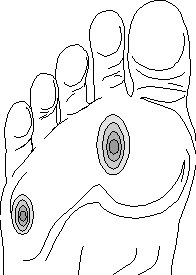| FOOT
DISORDERS -
Calluses |
Calluses are hyperkeratoses
of the skin. This is a thickening of the surface layer of the skin, usually in
response to pressure or friction. Calluses usually form on the ball of the foot,
the heel, and the underside of the big toe (hallux).
They may, however, form over any bony prominence. Calluses may be simple
thickening of the skin. Sometimes they have a deep seated "core", known as a
nucleation. This type of callus can be exquisitely
painful to pressure, and is known to the podiatrist as an Intractable
Plantar Keratosis.

- A hard growth usually on the ball of the
foot
- Pain on weight bearing, relieved by rest
- Increased discomfort in thin soled and high
heeled shoes
- More common in women than men
- High heeled shoes
- Malalignment of the
metatarsal bones
- Abnormalities of gait
- Flat feet and High arched feet
- Excessively long metatarsal bone
- Obesity
- Bony prominence
- Loss (atrophy) of
fat pad on the underside of the foot
- Short Achilles tendon
- Avoid high heeled shoes
- Buy shoes with a good arch and shock
absorbing rubber sole
- Use an insole which absorbs shear forces
inside the shoe (eg. SpencoŽ or SorbothaneŽ)
- Keep skin moist and supple with regular
application of a moisturizer
- Use a pumice stone or other abrasive to
reduce the thickness of the callus
- Apply non-medicated pads around the callus
to relieve pressure
- Apply moleskin over areas that tend to
callus
- Provide temporary relief by
debriding (pare down) the callus and any deep seated core it
may have.
- Apply various pads to relieve pressure
- Recommend appropriate shoes
- Prescribe orthotics to correct functional
problems and/or redistribute weight.
- Surgically realign metatarsals, or remove
bony prominences
- Bursitis - the
formation of a painful inflamed fluid-filled sac beneath the callus
- Discomfort of the back, hips, knees, legs,
or feet due to changes in posture and/or gait due to pain.
- Development of an ulcer.
An open area that forms within the callus. This may even extend down to
bone.
- Infection of the soft tissues or bone.
- Diabetics and those with
diminished circulation or sensation should always seek
professional help.
- Verruca (warts)
- Various tumors of the skin and
subcutaneous (below the skin) tissues
- Reaction to a foreign body
(e.g. sliver or animal hair)
- Genetic or metabolic disorders of the skin,
and some drug reactions.


